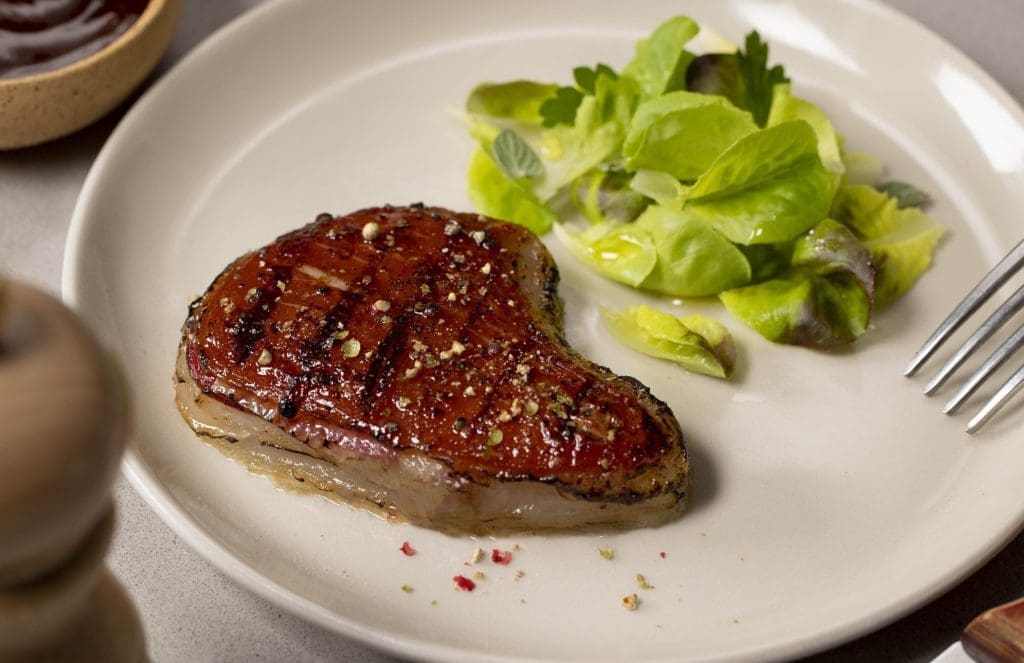
ISRAELI lab-grown meat technology developer Meatech has produced a beef sample for the first time combining cultured muscle and fat cells, produced in a realistic ‘structured, marbled steak form’ using 3D printing technology.
MeaTech said the bio-printed 3.67 ounce (104-gram) cultured steak comprised real, living muscle and fat tissues, without using any soy or pea protein typically used in plant-based alternatives.
The company believes that it is the largest cultured steak produced to date.
“This groundbreaking achievement serves as an important milestone toward the goal of scaled production of cultivated bio-printed steak,” Meatech said in a statement.
The cells used in making the steak were produced using an advanced and proprietary process that starts by isolating bovine stem cells from tissue samples and multiplying them*.
When sufficient cellular mass was produced, stem cells were formulated into bio-inks compatible with MeaTech’s proprietary 3D bio-printer. The bio-inks were printed from a digital design file of a steak structure. The printed product was placed in an incubator to mature, where the printed stem cells were differentiated into fat and muscle cells that develop into fat and muscle tissue, respectively, to form the MeaTech steak (see image).
MeaTech said its goal was to develop a ‘true replacement’ for conventional steak that maximises cell-based content rather than non-meat (plant-based) ingredients.
The company has developed its own advanced 3D bio-printing technology, combined with advanced tissue engineering science to reach the milestone, towards bringing “sustainable, premium cultivated meat products closer to the market.”
MeaTech intends to continue improving upon its bio-printing and cultivation technologies to produce cultivated meat that better mirrors the key characteristics of farm-raised, premium steak, the company’s statement said.
The steak produced today was the culmination of more than a year’s effort in the company’s cellular biology and high-throughput tissue engineering processes, MeaTech chief executive Sharon Fima said.
“By producing this 3.67oz steak comprised of living tissue, we believe we have both validated our core technologies and placed our company at the forefront of the race to develop high-end, real cell-based cultivated premium meat products,” she said.
MeaTech 3D is publicly listed on the US Nasdaq Capital Market under the ticker MITC. The company believes cultivated meat technologies hold significant potential to improve meat production, simplify the meat supply chain, and offer consumers a range of new product offerings.
The company is developing a suite of advanced manufacturing technologies to produce cell-based alternative protein products, including cell lines for beef, pork, and chicken.
- * Beef Central asked MeaTech via email whether the culture medium used to grow the muscle and fat cells was based on foetal calf blood, or some synthetic compound. We received the following response, after some delays caused by international time differences: “MeaTech’s cell culture media formulation is proprietary and therefore, we cannot disclose that.”

From a food scarcity point of view, this could be a massive game changer for many countries. IF it tastes like real meat, contains all the normal nutrition, isn’t bad for our health (like some of the weird processed foods you can currently consume) and the texture feels normal, I would absolutely try this. When you think of 3D printing, I visualize going into my workshop, printing up a quick slice of stake or chicken ready to cook in the evening. Sounds like science fiction.
Presumable the production of this product can not be produced from “thin air” therefore feedstocks are required. A clear understanding of these input would be very interesting.
The thought of eating that makes me feel a bit queasy really! I am very interested to hear what the culture is that they feed the cells with. I doubt it will be fresh cut well managed grass with a strong root system pouring tons of carbon into the soil!